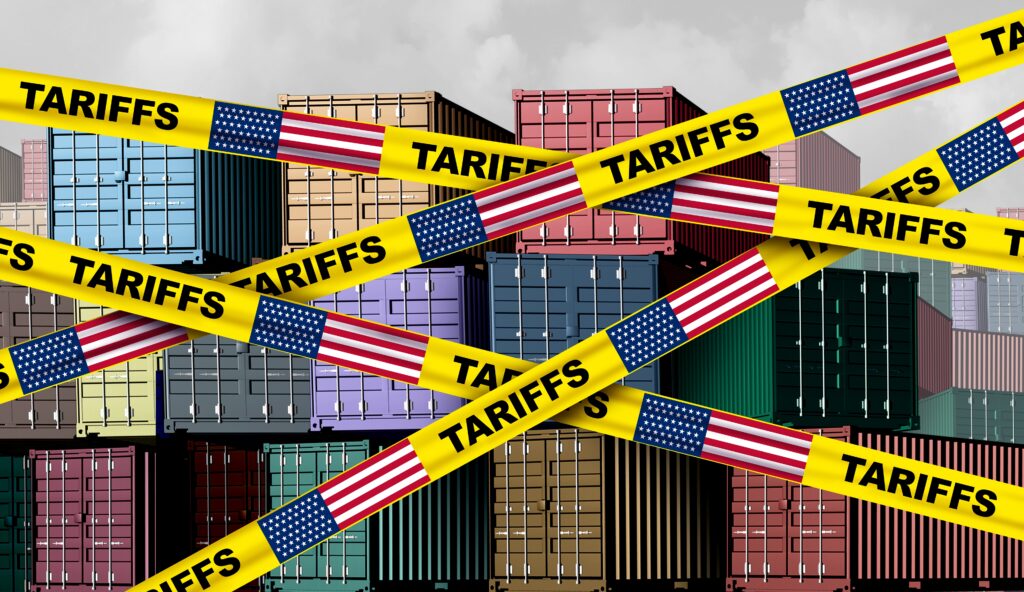
On April 2, President Trump introduced new trade measures affecting major trading partners around the world. These measures match what other countries charge on U.S. goods and come in addition to existing trade duties. The rates average 25% across countries, with some reaching 49%. While many expected these changes, their size and reach surprised both investors and economic experts. Markets responded with concern – stock prices fell more than 3% and government bond rates dropped to about 4%.
New trade measures match those of other countries

People have different views on international trade policies, and discussions can become heated. Whatever our personal opinions, we can see that these new measures represent an important shift in how countries do business with each other.
During uncertain times like these, it helps to remember that while markets may struggle briefly, they tend to recover over time. Looking back over the past hundred years, markets have weathered many challenges – from wars and economic downturns to health crises and major technological changes.
When things seem uncertain, some worry that markets won’t stabilize. But history shows markets can bounce back from major disruptions, often when least expected. We saw this after the 2008 financial crisis, during the 2020 pandemic, following the 2022 market decline, and many other times.
The key to long-term success is staying invested and following your financial plan – or even taking advantage of lower prices when they occur.
Here are the main details: The new measures start at 10%, with rates varying based on trade differences between countries. For example, China faces a 34% rate plus an earlier 20% rate. European countries will see 20% rates. Canada and Mexico keep their existing 25% rates related to border issues. All foreign cars now face a 25% rate.
The U.S. has a long history with trade measures. Before 1913, they were the main source of government money. Their use decreased after World War II as international trade grew.
The White House wants these measures to increase revenue and support U.S. manufacturing – part of their “make America wealthy again” approach. The President’s April 2 speech emphasized his goal of making trade more balanced.
Critics worry these measures will raise prices for everyday shoppers. This is especially important now when people are already dealing with higher costs. Some also point to history, noting that similar policies may have made the Great Depression worse and slowed global growth.
Market uncertainty increases as trade policies shift

For long-term investors, it’s important to understand that these trade changes will take time to unfold. The current changes started with the “America First Trade Policy” signed on January 20. While the President’s position on trade has been clear, people weren’t sure exactly what would happen. These latest moves show the administration is serious about making big changes, though details might still be negotiated with different countries.
The effects on markets and companies will become clearer over time, with some areas feeling more impact than others. The main worry is that these measures could push prices up while slowing down business activity. That’s why markets have reacted negatively this year.
Some U.S. manufacturers might benefit from less competition, but markets generally see trade barriers as bad for company profits in the short term. Companies need to adjust how they operate under new trade rules, possibly changing where they get materials or absorbing some higher costs themselves.
When similar measures happened in 2018, many large companies changed where they made things to avoid extra costs. They moved factories, found new suppliers, or reorganized their global operations. While these changes can help handle new trade measures, they take time to complete.
Companies that do lots of business overseas could see the biggest effects. About 30% of large U.S. company sales come from other countries, especially in technology, materials, communications, consumer goods, and energy sectors.
Besides affecting sales, these measures will likely increase costs for companies that buy materials from other countries. Before April 2, experts expected large company profits to grow 11.5% in 2025, down from earlier predictions of 14.2%. However, companies are currently making good profits and becoming more efficient, which could help cushion the impact.
When the U.S. dollar becomes weaker, it can actually help both investors and companies. International investments have done well this year, and overseas investments become worth more in dollars. For companies, a weaker dollar can help increase sales abroad because U.S. products become cheaper for foreign buyers.
Markets grow over time despite challenges

While markets reacted quickly to these changes, the full effects will take time to understand. In recent years, investors have faced many challenges – from the pandemic and rising prices to concerns about economic policies and recession fears. Each of these seemed very serious at the time.
However, markets recovered and reached new highs over the years. While past performance doesn’t guarantee future results, there are many reasons to believe markets and the economy can overcome current challenges too.
Warren Buffett made this point well during the 2008 financial crisis: “In the 20th century, the United States endured two world wars and other traumatic and expensive military conflicts; the Depression; a dozen or so recessions and financial panics; oil shocks; a flu epidemic; and the resignation of a disgraced president. Yet the Dow rose from 66 to 11,497.”
This reminds us that even though market declines can be worrying, history shows that keeping a long-term view is the best way to reach your financial goals.
The bottom line? Focus on what you can control as an investor. During times of market changes and policy shifts, the best approach is to maintain a long-term perspective and stick to your personal financial plan.
We are an independent financial services firm helping individuals create retirement strategies using a variety of investment and insurance products to custom suit their needs and objectives.
Advisory services offered through EGSI Investment Management, Inc., a Registered Investment Advisor with the State of Ohio. Insurance services offered through EGSI Financial, Inc.
Investing involves risk, including the potential loss of principal. No investment strategy can guarantee a profit or protect against loss in periods of declining values. None of the information contained on this website shall constitute an offer to sell or solicit any offer to buy a security or any insurance product.
Any references to protection benefits, safety, security, or steady and lifetime income streams on this website refer only to fixed insurance products. They do not refer, in any way, to securities or investment advisory products. Annuity guarantees are backed by the financial strength and claimspaying ability of the issuing insurance company. Annuities are insurance products that may be subject to fees, surrender charges and holding periods which vary by insurance company. Annuities are not FDIC insured.
The information and opinions contained in any of the material requested from this website are provided by third parties and have been obtained from sources believed to be reliable, but accuracy and completeness cannot be guaranteed. They are given for informational purposes only and are not a solicitation to buy or sell any of the products mentioned. The information is not intended to be used as the sole basis for financial decisions, nor should it be construed as advice designed to meet the particular needs of an individual’s situation.
Copyright (c) 2025 Clearnomics, Inc. All rights reserved. The information contained herein has been obtained from sources believed to be reliable, but is not necessarily complete and its accuracy cannot be guaranteed. No representation or warranty, express or implied, is made as to the fairness, accuracy, completeness, or correctness of the information and opinions contained herein. The views and the other information provided are subject to change without notice. All reports posted on or via www.clearnomics.com or any affiliated websites, applications, or services Powered by Clearnomics 4 are issued without regard to the specific investment objectives, financial situation, or particular needs of any specific recipient and are not to be construed as a solicitation or an offer to buy or sell any securities or related financial instruments. Past performance is not necessarily a guide to future results. Company fundamentals and earnings may be mentioned occasionally, but should not be construed as a recommendation to buy, sell, or hold the company’s stock. Predictions, forecasts, and estimates for any and all markets should not be construed as recommendations to buy, sell, or hold any security–including mutual funds, futures contracts, and exchange traded funds, or any similar instruments. The text, images, and other materials contained or displayed in this report are proprietary to Clearnomics, Inc. and constitute valuable intellectual property. All unauthorized reproduction or other use of material from Clearnomics, Inc. shall be deemed willful infringement(s) of this copyright and other proprietary and intellectual property rights, including but not limited to, rights of privacy. Clearnomics, Inc. expressly reserves all rights in connection with its intellectual property, including without limitation the right to block the transfer of its products and services and/or to track usage thereof, through electronic tracking technology, and all other lawful means, now known or hereafter devised. Clearnomics, Inc. reserves the right, without further notice, to pursue to the fullest extent allowed by the law any and all criminal and civil remedies for the violation of its rights.

